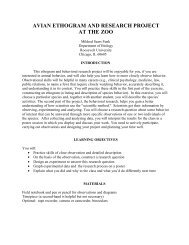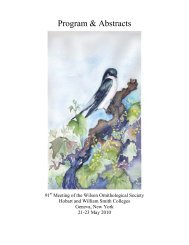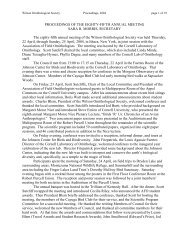OPTIMAL FORAGING BEHAVIOR: GROUP VS. SOLITARY ...
OPTIMAL FORAGING BEHAVIOR: GROUP VS. SOLITARY ...
OPTIMAL FORAGING BEHAVIOR: GROUP VS. SOLITARY ...
You also want an ePaper? Increase the reach of your titles
YUMPU automatically turns print PDFs into web optimized ePapers that Google loves.
REFERENCES<br />
Caraco, T. 1979. Time budgeting and group size: a test of theory. Ecology 60:618-627.<br />
_____., S. Martindale, and H. R. Pulliam. 1980. Flocking: advantages and<br />
disadvantages. Nature 285:400-401.<br />
Cody, M. L. 1971. Finch flocks in the Mohave Desert. Theor. Pop. Biol. 2:142-148.<br />
_____. 1974. Optimization in ecology. Science 183:1156-1164.<br />
Krebs, J. R., M. H. MacRoberts, and J. M. Cullen. 1972. Flocking and feeding in the<br />
great tit Parus major: an experimental study. Ibis 114:507-530.<br />
Pulliam, H. R., and T. Caraco. 1984. Living in groups: is there an optimal group size?<br />
Pages 122-147 In J. R. Krebs and N. B. Davies, eds. Behavioral Ecology: An<br />
Evolutionary Approach. Second Ed., Blackwell Scientific Publications, Oxford,<br />
England<br />
Verbeek, N. A. M. 1973. The exploitation system of the Yellow-billed Magpie. Univ.<br />
Calif. Publ. Zool. 99:1-58<br />
Zahavi, A. 1971. The social behavior of the White Wagtail Motacilla alba alba<br />
wintering in Israel. Ibis 113:203-211.





